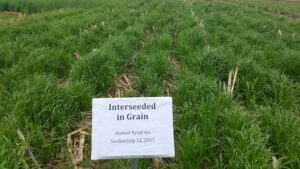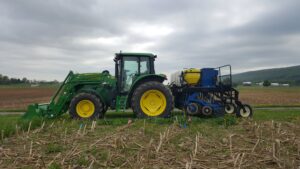Final report for GNE16-122
Project Information
Nitrate leaching from agricultural land is not only a source of pollution affecting waterways, air quality, and biodiversity, but also represents an economic loss for farmers. Cover crops (CC) can be used to reduce nitrate leaching, however establishing a CC after a corn grain harvest can be difficult in the Northeast. One solution to this constraint is to establish a CC by interseeding into a standing corn crop. While interest in CC interseeding is growing rapidly, there is very little scientific information to document the magnitude or mechanisms of change in the nitrogen (N) cycle from this practice. The goals of this project were to experimentally test CC interseeding as a strategy to reduce N leaching in organic corn production, and to develop and deliver outreach to regional farmers regarding potential benefits and costs associated with interseeding. In a factorial field experiment, three CC treatments and two rates of fertilizer application were examined in organic corn grain and silage systems. CC treatments included an interseeded ryegrass CC, a traditional cereal rye monoculture CC planted after corn harvest, and a no-CC treatment. We quantifed differences in CC- N uptake, microbial community composition, and microbial N dynamics among treatments. Additionally, we estimated effects of CC – microbial linkages on nitrate leaching and N availability to subsequent cash crop. We found that there is a similar capacity for N retention and reduced N leaching in interseeded ryegrass and post-harvest cereal rye, and that this this reduced leaching was driven by N storage in cover crop biomass. Unexpectedly, microbial biomass was similar in all treatments. This is potentially because carbon from other sources (i.e. corn roots, stover, weeds) dominate in this system.
- Quantify differences in CC-N uptake between an interseeded ryegrass cover crop (INT) and a traditional cereal rye monoculture CC (POST) planted after corn grain harvest, as well as after corn silage harvest.
- Quantify potential of microbiota in interseeded systems as a N sink in INT, POST and in a fallow treatment with no cover crop (FALLOW).
- Estimate effects of CC – microbial linkages on nitrate leaching in grain and silage.
- Estimate effects of cover crop – microbial linkages on N availability to subsequent cash crop.
- Estimate differences in soil microbial communities between interseeded and non-interseeded corn at different soil N levels.
- Make recommendations to organic grain farmers, extension agents, other researchers, and agriculture professionals in the Northeast about the potential benefits and costs associated with interseeding CCs in regards to N retention services.
The purpose of this project is to experimentally test cover crop (CC) interseeding as a strategy to reduce nitrate leaching in organic corn production, and to develop and deliver outreach to regional farmers regarding potential benefits and costs associated with interseeding. This proposal focuses on nitrogen (N) management because it is a critical agronomic challenge with environmental and economic implications on a local, regional, and global scale (1). Nitrate leaching is not only a source of pollution affecting waterways, air quality, and biodiversity, but also represents economic losses to farmers. By investing in research exploring innovative ways to mitigate N losses from agricultural systems without sacrificing yields, we can build knowledge with direct links to agricultural sustainability: the reduction of environmental and health risks associated with nitrate leaching into the water supply, the improvement of economic productivity for farmers, and the conservation of soil, improvement of water quality, and protection of natural resources.
As the demand for organic grain has increased in the Northeast, there has been increased interest among farmers in adopting organic and sustainable grain growing practices (2). Therefore, it is imperative to develop organic grain cropping systems that have the potential to provide agronomic and economic benefits to farmers while also mitigating N losses to the environment.
Cover cropping, a common practice among organic grain farmers, can provide a suite of benefits, including improved soil quality, increased N retention, and reduced N losses (3,4). CC species can be selected to target specific ecosystem services. Grass CCs may be selected to serve as N scavengers, while legume CCs function as N fixers. The temporal dynamics of CCs are important to consider when utilizing them for N management; CCs may serve as an N source or sink at different points in the season. Additionally, there is a linkage between CCs and soil microbes that plays a key role in N retention (5). Soil microbial communities are also temporally N sources or sinks in soil, and understanding how these plant-microbial linkages impact soil N loss and retention in agricultural systems is a pivotal environmental and economic need.
In the Northeast, short and increasingly unpredictable fall and spring seasons can cause problems with establishing a CC following corn harvest, an issue identified both in the scientific literature and by farmers (6, 7). Additionally, high levels of residual N susceptible to leaching can occur following a corn crop under dry summer conditions (6). Interseeding CCs into standing cash crops has recently gained interest as a strategy to address these constraints (8). In 2015 there were as many as 4,047 ha (10,000 ac) of corn interseeded in northeastern United States as well as in Ontario and Quebec (8). By interseeding a CC mid-summer, the risk of not being able to establish a cover in the fall is eliminated. While there are ongoing trials of the effects of interseeding CCs in corn, most of these trials are taking place in conventional systems, and most are focused on weed management (9). To our knowledge, this study would be the first to directly evaluate the effects of interseeding CCs on the potential to decrease residual N and therefore decrease N leaching.
A recently completed project at The Pennsylvania State University funded by USDA OREI and entitled “A Reduced-Tillage Toolbox: Alternative approaches for integrating cover crops and reduced tillage in an organic feed and forage system” (RTT) was developed based on knowledge gained from previous experiments as well as grower- identified constraints (7). The RTT project has been critical for development of the current proposal. First, the project provides a platform for outreach that we will leverage: farmer participation in research and extension activities as well as on project advisory boards. Second, the project provided a field site where we gathered preliminary data on N retention in interseeded systems. The RTT experiment includes CC interseeded into corn grain; however, because it is a systems experiment, it is difficult to tease out the effects of interseeding on different N dynamics. In all cases, the effects of interseeding are confounded by differences in tillage, CC species, etc. Furthermore, our preliminary data (soil inorganic N, leaching, and corn yield) suggest that all treatments in this experiment had low N availability to corn, providing a weak test of the role of CCs in N retention. Consequently, the experiment proposed here is required to directly tie effects of interseeding to N retention services, microbial community shifts, and crop yields in fields with a range of N fertilizer inputs.
Overall, the justification for our proposed work is that in order to make scientifically-based recommendations to farmers, we must first piece together a picture of the timing and magnitude of N flow when CC are interseeded into corn grain and silage.
Citations:
- Gardner, J. B., & Drinkwater, L. E. 2009. Ecological Applications,19(8), 2167-2184.
- Roth G.W. 2012. Organic Corn Production. State College, PA: The Pennsylvania State University, Penn State http://extension.psu.edu/plants/crops/grains/corn/production/organic-corn-production
- Schipanski, M. E., Barbercheck, M., Douglas, M. R., Finney, D. M., Haider, K., Kaye, J. P., Kemanian, A.R., Mortensen, D.A., Ryan, M.R., Tooker, J. and White, C. 2014. A framework for evaluating ecosystem services provided by cover crops in agroecosystems.Agricultural Systems, 125, 12-22.
- Finney, D. M., Eckert, S. E., & Kaye, J. P. 2015. Drivers of nitrogen dynamics in ecologically based agriculture revealed by long-term, high-frequency field measurements. Ecological Applications, 25(8), 2210-2227.
- de Vries, F. T., & Bardgett, R. D. 2012. Plant-microbial linkages and ecosystem nitrogen retention: lessons for sustainable agriculture. Frontiers in Ecology and the Environment, 10(8), 425-432.
- Ketterings, Quirine M., Sheryl N. Swink, Sjoerd W. Duiker, Karl J. Czymmek, Douglas B. Beegle, and William J. Cox. "Integrating cover crops for nitrogen management in corn systems on Northeastern US dairies." Agronomy Journal 107, no. 4 (2015): 1365-1376.
- Barbercheck, M., Curran, W., Kaye, J.P., S., Wallace, J. 2014. Project Narrative – A Reduced-Tillage Toolbox: Alternative approaches for integrating cover crops and reduced-tillage in an organic feed and forage system. OREI Project Proposal.
- Groff, S. 2015. The past, present, and future of the cover crop industry. Journal of Soil and Water Conservation, 70(6), 130A-133A.
- Roth, G.W., W.S. Curran, C. Dillon, C. Houser, and W.S. Harkcom. 2015. Cover Crop Interseeder and State College, PA: The Pennsylvania State University, Penn State Extension. http://extension.psu.edu/ plants/crops/soil-management/cover-crops/ interseeder-applicator.
Research
This experiment was conducted at the Penn State Agronomy Farm at the Russell E. Larson Agricultural Research Center (RELARC) in Centre County, PA. This experiment ran for one season only due to failure of cover crops to establish in the second attempted experimental season. Crops were managed according to USDA organic standards throughout the experiment, though the land is not certified organic.
Experimental design: This was a factorial experiment with a randomized block design and four replications. The experiment included two factors – a cover crop factor and a fertilizer application factor - assigned randomly in a split plot design in a corn grain crop with cover crop treatments applied at the sub-plot level. An additional plot in each block was harvested for corn silage. With the exception of the applied treatments, the entire experiment was managed consistently in terms of timing and methods of tillage, manure application, planting, and cultivation. Each plot was 12m x 6m (40 ft x 20 ft).
Factors and Treatments: The cover crop factor included three treatments as follows: 1) a treatment with no cover crop post-harvest (FALLOW), 2) a treatment that has a cereal rye CC established after corn harvest (POST) at 135 kg/ha (120 lbs/acre), and 3) an interseeded treatment using annual ryegrass applied at 18 kg/ha (20 lbs/acre) as the interseeded CC (INT). The POST treatment is a common practice in the Northeast, though it is also common for farmers to forgo cover cropping after corn grain (FALLOW). INT was seeded at the final cultivation when corn was V5-V6 stage. Seeding rates of the interseeded cover crop were determined from Penn State Extension publications on interseeding cover crops in corn. Species selection for the interseeded treatments was based on prior experience in the Reduced Tillage Toobox experiment and other interseeding trials at Penn State; annual ryegrass has proven very reliable for establishment under corn canopies.
The fertilizer application factor included two levels of application as follows: 1) manure to meet the N demands of the corn crop in a split application: half applied at planting and half applied at last cultivation (M1), and 2) manure to exceed the N demands of the corn crop applied in three applications: at planting, last cultivation, and harvest (a soymeal based fertilizer was used and spread by hand for the final application). Manure application rates were determined using guidelines in the Penn State Organic Production Guide along with information from the manure analysis report of the manure being used. Having high N addition rates ensures residual N in the soil, which will allow us to better assess the differences in the fate of this residual N among interseeding treatments.
Plot management and equipment: Before corn planting, the site was moldboard plowed and disked. Corn grain variety, seeding rates, planting date and cultivation followed the Penn State Organic Crop Production Guide. Interseeding was done with the InterSeeder Cover Crop Planter by InterSeeder Technologies. This planter drilled three rows of cover crop seed in between each corn row. Sub- samples of each plot were harvested to compare relative corn yields.
Analysis of response variables:
Objective 1. We measured CC N uptake by analyzing the N content in biomass samples of the CCs at two points in the season. The first CC biomass sample was taken in early December to represent peak fall biomass (before a hard frost), and the second was taken in May to represent peak spring biomass (before a tillage/termination event). At each sampling event, we clipped the above ground biomass from two 0.5 m2 quadrats in each plot. This biomass was oven dried, weighed, and ground into a fine powder. A subsample of this powder was analyzed for N concentration by combustion analysis. The same process was used to determine N concentration in corn plant tissue from a subsample of each plot.
Objective 2. To estimate differences in microbial biomass and activity, we used a lab incubation as well as soil cores incubated in situ. We collected soils at 10 cm depth after interseeding, and twice more after harvest. These soils were dried and stored for later incubation using the CO2 burst method. Briefly, soils were rewetted and incubated in a closed container for 7 days. Accumulated CO2 was then measured from the headspace using a LI-COR gas analyzer. Initial and final inorganic N extractions were also done. Results from this method have been shown to be directly proportional to microbial biomass, and tied to potential C and N mineralization. Additionally, three capped cores were installed in each plot and incubated for 2 weeks. Cores were 10 cm depth. A co-located 10 cm depth soil sample was also taken at the time of core installation. Inorganic nitrogen was extracted from these soil cores and the initial soil sample with 2M KCl and were analyzed for nitrate and ammonium concentrations via colorimetric analysis. The difference between the initial soil sample and the incubated soil were used to estimate N mineralization rates. We conducted 2 rounds of 2 week incubations in all plots in November and December.
Objective 3: On the same day as corn planting, we buried four positively charged resin bags in each plot. These resin bags were buried below the bottom of the plow layer (35 cm). The resins were positively charged and attract and hold negatively charged nitrate. Two resins from each plot were removed before the winter (at peak fall biomass), and the final two were removed from the field in the spring before cover crop termination. This sequential removal allowed us to quantify temporal differences in leaching among treatments. They were extracted with 3 M KCl, and the extract was analyzed for nitrate concentrations through colorimetric methods. These concentrations were used to estimate differences in nitrate leaching among the treatments. We also tracked the concentration of inorganic N in surface soils at critical points throughout the experiment to document when surface N was available for nitrification or nitrate leaching.
Objective 4: To estimate effects of CC – microbial linkages on N availability to subsequent cash crop, May samples of CC- N (see Obj.1), soil inorganic N (see Obj.3), and total microbial biomass (see Obj. 2 and 5) were used to determine mechanisms governing CC effects on N availability in the season following cash crop harvest.
Objective 5: Microbial community shifts were evaluated with a phospholipid fatty acid (PLFA) analysis. This analysis was done on samples from the December soil sampling to elucidate any differences between treatments at the end of the fall when all CCs are fully established, as well as the May sampling to estimate effects of treatments on the following crop year. The PLFA analysis allows us to determine a ratio of fungal to bacterial microbial biomass, as well as to see any effects of the treatments on specific groups of soil microbes. Additionally, 16s rRNA amplicon sequencing was used to compare soil bacterial community taxonomic composition among treatments from samples in both December and the following spring.
There were no differences in soil inorganic nitrogen (SIN) in the top 10 cm of soil between cover cropping treatments during the corn growing season. The significant difference in late fall SIN was generated by the high N treatment (Figure 1). We did, however, see differences in the spring in SIN throughout the deeper soil profile (Figure 2 and 3). Although there are similar N levels among treatments in the top 20 cm of soil, moving down through the soil profile it is apparent that the treatments with cover crops are reducing the N pools (as opposed to fallow treatments). In other cover cropping experiments at the same site where nitrate leaching is directly measured, we see similar data in terms of ammonium and nitrate distribution through the profile. Our data from this experiment in the cover cropped treatments match systems that have lower nitrate leaching, allowing us to feel confidently conclude that the cover cropped treatments are reducing leaching and that the post-harvest cereal rye and the interseeded ryegrass have similar capacities to reduce nitrate loss.
Aboveground biomass data was used to examine the potential of the cover crops as N sinks. Figure 4 shows dry cover crop biomass in kg/ha of fall interseeded ryegrass, spring interseeded ryegrass, and spring cereal rye. Spring biomass was highest in the cereal rye treatment, which is not surprising because of the different life history traits of these two cover crop species. However, when we measured the N contained in that aboveground biomass (Figure 5), we found that because of the higher percent N content of the ryegrass, there is similar N retention provided by both cover crop species in these two treatments.
An unexpected result was obtained from the phospholipid fatty acid (PLFA) analysis of the top 10 cm of soil. PLFA is used as an index of microbial biomass. We found no differences in total PLFA among treatments in the fall and in the spring, indicating that there is no difference in the retention of N by this microbial pool (Figure 6). This was surprising, as we had hypothesized increased microbial biomass - and therefore increased N retention - in the interseeded systems because of increased carbon inputs from living roots. One possible reason for this result could be the high carbon inputs into these systems from corn residue, which may be overwhelming the signal of any differences in the microbial biomass driven by cover crop species or SIN. PLFA data show differences in soil microbial communities (Figure 7) clustering by season, but not necessarily by treatments. 16s rRNA amplicon sequencing (currently underway) will allow us higher taxonomic resolution to further tease out community differences among treatments.
figures-annual-report-sare-20181
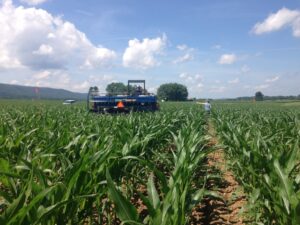
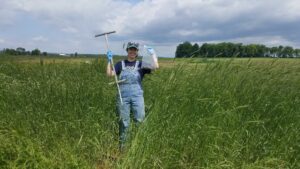
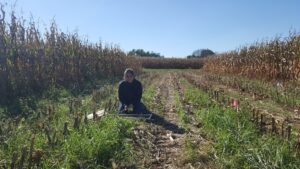
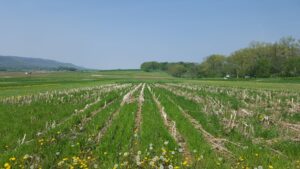
- There is a similar capacity for N retention and reduced N leaching in interseeded ryegrass and post-harvest cereal rye.
- This observed reduced leaching was driven by N storage in cover crop biomass.
- Microbial biomass was similar in all treatments. This is potentially because carbon from other sources dominate in this system.
- These results suggest that interseeding cover crops in organic grain systems is a viable option to provide nitrogen retention services.
Education & Outreach Activities and Participation Summary
Received outside funding for an undergraduate (Taran Rowles) to be mentored in our lab group through helping with the laboratory soil incubations.
Participation Summary:
Article published in winter newsletter "The ROSE Review" (Reduced-Tillage Organic Systems Experiment) for the project “A Reduced-Tillage Toolbox: Alternative approaches for integrating cover crops and reduced tillage in an organic feed and forage system.” This periodic newsletter highlights the research and extension activities associated with the project. This is a multi-disciplinary project was funded by the USDA's Organic Research and Extension Initiative (OREI) and was initiated in the fall of 2014. ROSE includes experiments located at the Russell E. Larson Research Center in Rock Springs, PA as well as on three organic farms. This article detailed the new research project "Interseeded cover crops" funded by the SARE grant and gave a brief overview of its justification, objectives, and potential environmental and economic contributions. ROSE.Review-Spring17
On farm demonstration (informal) 2018: Interseeding into organic corn with the InterSeeder(tm) technologies drill. Demonstration was attended by several visiting international scholars and several graduate students from Penn State.
Oral presentation at a national conference: 2018 Isbell, S., Kaye, J. Nitrogen Services Provided By Interseeded Cover Crops in Organic Corn Systems. ASA, CSSA, & CSA Annual Meeting. Baltimore, MD. *awarded 2nd place in graduate student competition
Poster presentation at regional conference: 2018 Isbell, S., Kaye, J. Nitrogen Services Provided By Interseeded Cover Crops in Organic Corn Systems. Northeast Cover Crops Council Annual Meeting, State College, PA.
Field day/workshop: 2018 S.Isbell, G. Roth. Interseeding cover crops in corn in the northeast. “Maleza en Foco” Argentinean Cover Crops Clinic field day. Russell E. Larson Agricultural Research Center, Rock Springs, PA. Participated as one stop on a full day tour attended by farmers, educators, and industry professionals from Argentina.
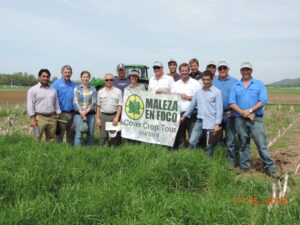
Oral presentation at symposium: 2019 Isbell, S., Kaye, J. Nitrogen retention services provided by plant-microbial linkages in organic interseeded cover cropping systems. Environmental Chemistry & Microbiology Student Symposium, Penn State University, PA. *awarded 2nd place in graduate student competition
Undergraduate mentee: WMF is a student research internship program at Penn State – University Park supported by the NASA Pennsylvania Space Grant Consortium. This program offers first-year students a two-semester (spring and fall semesters of one calendar year) faculty mentored internship in a research laboratory. Undergraduate Taran Rowles is being mentored by graduate student Sarah Isbell through this program, and they are working together on laboratory soil incubations to estimate differences in potential for nitrogen mineralization as well as microbial activity. Taran will present a poster at the WMF research symposium in November 2019.
Planned journal articles: Two journal articles are planned. The first (in progress) will focus on objectives 1 - 6, and the second will focus on objective 5 using the 16s rRNA amplicon sequencing data to illuminate soil bacterial community differences among treatments. Potential journals are Agronomy Journal, Ecosphere, and Renewable Agriculture and Food Systems.
Planned Extension Article: One article published online through Penn State extension will summarize the main findings of this experiment and make recommendations to farmers about interseeding for nitrogen retention services (Objective 6).

